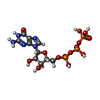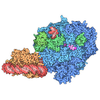+ Open data
Open data
- Basic information
Basic information
| Entry |  | |||||||||
|---|---|---|---|---|---|---|---|---|---|---|
| Title | Cryo-EM structure of the TBC-D-Arl2-beta-tubulin complex | |||||||||
 Map data Map data | ||||||||||
 Sample Sample |
| |||||||||
 Keywords Keywords | chaperone / complex | |||||||||
| Function / homology |  Function and homology information Function and homology informationTransport of nucleosides and free purine and pyrimidine bases across the plasma membrane / post-chaperonin tubulin folding pathway / cell morphogenesis involved in neuron differentiation / Regulation of PLK1 Activity at G2/M Transition / Loss of Nlp from mitotic centrosomes / Loss of proteins required for interphase microtubule organization from the centrosome / Anchoring of the basal body to the plasma membrane / AURKA Activation by TPX2 / Recruitment of mitotic centrosome proteins and complexes / odontoblast differentiation ...Transport of nucleosides and free purine and pyrimidine bases across the plasma membrane / post-chaperonin tubulin folding pathway / cell morphogenesis involved in neuron differentiation / Regulation of PLK1 Activity at G2/M Transition / Loss of Nlp from mitotic centrosomes / Loss of proteins required for interphase microtubule organization from the centrosome / Anchoring of the basal body to the plasma membrane / AURKA Activation by TPX2 / Recruitment of mitotic centrosome proteins and complexes / odontoblast differentiation / Post-chaperonin tubulin folding pathway / negative regulation of GTPase activity / tubulin complex assembly / bicellular tight junction assembly / Neutrophil degranulation / maintenance of protein location in nucleus / adherens junction assembly / centrosome cycle / positive regulation of cell-substrate adhesion / Recruitment of NuMA to mitotic centrosomes / regulation of glycolytic process / regulation of aerobic respiration / negative regulation of microtubule polymerization / regulation of synapse organization / nuclear envelope lumen / MHC class I protein binding / regulation of microtubule polymerization / lateral plasma membrane / negative regulation of cell-substrate adhesion / bicellular tight junction / beta-tubulin binding / intercellular bridge / spindle assembly / positive regulation of microtubule polymerization / GTPase activator activity / adherens junction / structural constituent of cytoskeleton / mitochondrial intermembrane space / microtubule cytoskeleton organization / cytoplasmic ribonucleoprotein granule / RAS processing / mitotic spindle / GDP binding / protein folding / mitotic cell cycle / protein-folding chaperone binding / microtubule cytoskeleton / cell body / microtubule / ciliary basal body / mitochondrial matrix / GTPase activity / ubiquitin protein ligase binding / centrosome / GTP binding / nucleolus / mitochondrion / nucleoplasm / metal ion binding / nucleus / cytosol / cytoplasm Similarity search - Function | |||||||||
| Biological species |  Homo sapiens (human) / Homo sapiens (human) /  | |||||||||
| Method | single particle reconstruction / cryo EM / Resolution: 2.48 Å | |||||||||
 Authors Authors | Seong YJ / Kim HM / Byun KM / Park YW / Roh SH | |||||||||
| Funding support |  Korea, Republic Of, 1 items Korea, Republic Of, 1 items
| |||||||||
 Citation Citation |  Journal: Science / Year: 2025 Journal: Science / Year: 2025Title: Structural dissection of alpha beta-tubulin heterodimer assembly and disassembly by human tubulin-specific chaperones Authors: Seong YJ / Kim HM / Byun KM / Park YW / Roh SH | |||||||||
| History |
|
- Structure visualization
Structure visualization
| Supplemental images |
|---|
- Downloads & links
Downloads & links
-EMDB archive
| Map data |  emd_63572.map.gz emd_63572.map.gz | 179 MB |  EMDB map data format EMDB map data format | |
|---|---|---|---|---|
| Header (meta data) |  emd-63572-v30.xml emd-63572-v30.xml emd-63572.xml emd-63572.xml | 21.4 KB 21.4 KB | Display Display |  EMDB header EMDB header |
| FSC (resolution estimation) |  emd_63572_fsc.xml emd_63572_fsc.xml | 12.6 KB | Display |  FSC data file FSC data file |
| Images |  emd_63572.png emd_63572.png | 72.5 KB | ||
| Filedesc metadata |  emd-63572.cif.gz emd-63572.cif.gz | 6.9 KB | ||
| Others |  emd_63572_additional_1.map.gz emd_63572_additional_1.map.gz emd_63572_half_map_1.map.gz emd_63572_half_map_1.map.gz emd_63572_half_map_2.map.gz emd_63572_half_map_2.map.gz | 197.7 MB 194.5 MB 194.5 MB | ||
| Archive directory |  http://ftp.pdbj.org/pub/emdb/structures/EMD-63572 http://ftp.pdbj.org/pub/emdb/structures/EMD-63572 ftp://ftp.pdbj.org/pub/emdb/structures/EMD-63572 ftp://ftp.pdbj.org/pub/emdb/structures/EMD-63572 | HTTPS FTP |
-Validation report
| Summary document |  emd_63572_validation.pdf.gz emd_63572_validation.pdf.gz | 986 KB | Display |  EMDB validaton report EMDB validaton report |
|---|---|---|---|---|
| Full document |  emd_63572_full_validation.pdf.gz emd_63572_full_validation.pdf.gz | 985.6 KB | Display | |
| Data in XML |  emd_63572_validation.xml.gz emd_63572_validation.xml.gz | 21.3 KB | Display | |
| Data in CIF |  emd_63572_validation.cif.gz emd_63572_validation.cif.gz | 27.8 KB | Display | |
| Arichive directory |  https://ftp.pdbj.org/pub/emdb/validation_reports/EMD-63572 https://ftp.pdbj.org/pub/emdb/validation_reports/EMD-63572 ftp://ftp.pdbj.org/pub/emdb/validation_reports/EMD-63572 ftp://ftp.pdbj.org/pub/emdb/validation_reports/EMD-63572 | HTTPS FTP |
-Related structure data
| Related structure data |  9m1iMC  9m1jC  9m1kC  9m1lC  9m1mC  9m1nC M: atomic model generated by this map C: citing same article ( |
|---|---|
| Similar structure data | Similarity search - Function & homology  F&H Search F&H Search |
- Links
Links
| EMDB pages |  EMDB (EBI/PDBe) / EMDB (EBI/PDBe) /  EMDataResource EMDataResource |
|---|---|
| Related items in Molecule of the Month |
- Map
Map
| File |  Download / File: emd_63572.map.gz / Format: CCP4 / Size: 209.3 MB / Type: IMAGE STORED AS FLOATING POINT NUMBER (4 BYTES) Download / File: emd_63572.map.gz / Format: CCP4 / Size: 209.3 MB / Type: IMAGE STORED AS FLOATING POINT NUMBER (4 BYTES) | ||||||||||||||||||||||||||||||||||||
|---|---|---|---|---|---|---|---|---|---|---|---|---|---|---|---|---|---|---|---|---|---|---|---|---|---|---|---|---|---|---|---|---|---|---|---|---|---|
| Projections & slices | Image control
Images are generated by Spider. | ||||||||||||||||||||||||||||||||||||
| Voxel size | X=Y=Z: 0.7205 Å | ||||||||||||||||||||||||||||||||||||
| Density |
| ||||||||||||||||||||||||||||||||||||
| Symmetry | Space group: 1 | ||||||||||||||||||||||||||||||||||||
| Details | EMDB XML:
|
-Supplemental data
-Additional map: #1
| File | emd_63572_additional_1.map | ||||||||||||
|---|---|---|---|---|---|---|---|---|---|---|---|---|---|
| Projections & Slices |
| ||||||||||||
| Density Histograms |
-Half map: #2
| File | emd_63572_half_map_1.map | ||||||||||||
|---|---|---|---|---|---|---|---|---|---|---|---|---|---|
| Projections & Slices |
| ||||||||||||
| Density Histograms |
-Half map: #1
| File | emd_63572_half_map_2.map | ||||||||||||
|---|---|---|---|---|---|---|---|---|---|---|---|---|---|
| Projections & Slices |
| ||||||||||||
| Density Histograms |
- Sample components
Sample components
-Entire : Complex of tubulin specific chaperone D, Arl2 and beta-tubulin
| Entire | Name: Complex of tubulin specific chaperone D, Arl2 and beta-tubulin |
|---|---|
| Components |
|
-Supramolecule #1: Complex of tubulin specific chaperone D, Arl2 and beta-tubulin
| Supramolecule | Name: Complex of tubulin specific chaperone D, Arl2 and beta-tubulin type: complex / ID: 1 / Parent: 0 / Macromolecule list: #1-#3 |
|---|---|
| Molecular weight | Theoretical: 200 KDa |
-Supramolecule #2: TBCD-Arl2
| Supramolecule | Name: TBCD-Arl2 / type: complex / ID: 2 / Parent: 1 / Macromolecule list: #1-#2 |
|---|---|
| Source (natural) | Organism:  Homo sapiens (human) Homo sapiens (human) |
-Supramolecule #3: beta-tubulin
| Supramolecule | Name: beta-tubulin / type: complex / ID: 3 / Parent: 1 / Macromolecule list: #3 |
|---|---|
| Source (natural) | Organism:  |
-Macromolecule #1: Tubulin-specific chaperone D
| Macromolecule | Name: Tubulin-specific chaperone D / type: protein_or_peptide / ID: 1 / Number of copies: 1 / Enantiomer: LEVO |
|---|---|
| Source (natural) | Organism:  Homo sapiens (human) Homo sapiens (human) |
| Molecular weight | Theoretical: 132.752516 KDa |
| Recombinant expression | Organism:  Homo sapiens (human) Homo sapiens (human) |
| Sequence | String: MALSDEPAAG GPEEEAEDET LAFGAALEAF GESAETRALL GRLREVHGGG AEREVALERF RVIMDKYQEQ PHLLDPHLEW MMNLLLDIV QDQTSPASLV HLAFKFLYII TKVRGYKTFL RLFPHEVADV EPVLDLVTIQ NPKDHEAWET RYMLLLWLSV T CLIPFDFS ...String: MALSDEPAAG GPEEEAEDET LAFGAALEAF GESAETRALL GRLREVHGGG AEREVALERF RVIMDKYQEQ PHLLDPHLEW MMNLLLDIV QDQTSPASLV HLAFKFLYII TKVRGYKTFL RLFPHEVADV EPVLDLVTIQ NPKDHEAWET RYMLLLWLSV T CLIPFDFS RLDGNLLTQP GQARMSIMDR ILQIAESYLI VSDKARDAAA VLVSRFITRP DVKQSKMAEF LDWSLCNLAR SS FQTMQGV ITMDGTLQAL AQIFKHGKRE DCLPYAATVL RCLDGCRLPE SNQTLLRKLG VKLVQRLGLT FLKPKVAAWR YQR GCRSLA ANLQLLTQGQ SEQKPLILTE DDDEDDDVPE GVERVIEQLL VGLKDKDTVV RWSAAKGIGR MAGRLPRALA DDVV GSVLD CFSFQETDKA WHGGCLALAE LGRRGLLLPS RLVDVVAVIL KALTYDEKRG ACSVGTNVRD AACYVCWAFA RAYEP QELK PFVTAISSAL VIAAVFDRDI NCRRAASAAF QENVGRQGTF PHGIDILTTA DYFAVGNRSN CFLVISVFIA GFPEYT QPM IDHLVTMKIS HWDGVIRELA ARALHNLAQQ APEFSATQVF PRLLSMTLSP DLHMRHGSIL ACAEVAYALY KLAAQEN RP VTDHLDEQAV QGLKQIHQQL YDRQLYRGLG GQLMRQAVCV LIEKLSLSKM PFRGDTVIDG WQWLINDTLR HLHLISSH S RQQMKDAAVS ALAALCSEYY MKEPGEADPA IQEELITQYL AELRNPEEMT RCGFSLALGA LPGFLLKGRL QQVLTGLRA VTHTSPEDVS FAESRRDGLK AIARICQTVG VKAGAPDEAV CGENVSQIYC ALLGCMDDYT TDSRGDVGTW VRKAAMTSLM DLTLLLARS QPELIEAHTC ERIMCCVAQQ ASEKIDRFRA HAASVFLTLL HFDSPPIPHV PHRGELEKLF PRSDVASVNW S APSQAFPR ITQLLGLPTY RYHVLLGLVV SLGGLTESTI RHSTQSLFEY MKGIQSDPQA LGSFSGTLLQ IFEDNLLNER VS VPLLKTL DHVLTHGCFD IFTTEEDHPF AVKLLALCKK EIKNSKDIQK LLSGIAVFCE MVQFPGDVRR QALLQLCLLL CHR FPLIRK TTASQVYETL LTYSDVVGAD VLDEVVTVLS DTAWDAELAV VREQRNRLCD LLGVPRPQLV PQPGAC UniProtKB: Tubulin-specific chaperone D |
-Macromolecule #2: ADP-ribosylation factor-like protein 2
| Macromolecule | Name: ADP-ribosylation factor-like protein 2 / type: protein_or_peptide / ID: 2 / Number of copies: 1 / Enantiomer: LEVO |
|---|---|
| Source (natural) | Organism:  Homo sapiens (human) Homo sapiens (human) |
| Molecular weight | Theoretical: 20.903992 KDa |
| Recombinant expression | Organism:  Homo sapiens (human) Homo sapiens (human) |
| Sequence | String: MGLLTILKKM KQKERELRLL MLGLDNAGKT TILKKFNGED IDTISPTLGF NIKTLEHRGF KLNIWDVGGQ KSLRSYWRNY FESTDGLIW VVDSADRQRM QDCQRELQSL LVEERLAGAT LLIFANKQDL PGALSSNAIR EVLELDSIRS HHWCIQGCSA V TGENLLPG IDWLLDDISS RIFTAD UniProtKB: ADP-ribosylation factor-like protein 2 |
-Macromolecule #3: Tubulin beta chain
| Macromolecule | Name: Tubulin beta chain / type: protein_or_peptide / ID: 3 / Number of copies: 1 / Enantiomer: LEVO |
|---|---|
| Source (natural) | Organism:  |
| Molecular weight | Theoretical: 49.717629 KDa |
| Recombinant expression | Organism:  |
| Sequence | String: MREIVHIQAG QCGNQIGAKF WEVISDEHGI DPTGTYHGDS DLQLDRISVY YNEATGGKYV PRAILVDLEP GTMDSVRSGP FGQIFRPDN FVFGQSGAGN NWAKGHYTEG AELVDSVLDV VRKEAESCDC LQGFQLTHSL GGGTGSGMGT LLISKIREEY P DRIMNTFS ...String: MREIVHIQAG QCGNQIGAKF WEVISDEHGI DPTGTYHGDS DLQLDRISVY YNEATGGKYV PRAILVDLEP GTMDSVRSGP FGQIFRPDN FVFGQSGAGN NWAKGHYTEG AELVDSVLDV VRKEAESCDC LQGFQLTHSL GGGTGSGMGT LLISKIREEY P DRIMNTFS VVPSPKVSDT VVEPYNATLS VHQLVENTDE TYCIDNEALY DICFRTLKLT TPTYGDLNHL VSATMSGVTT CL RFPGQLN ADLRKLAVNM VPFPRLHFFM PGFAPLTSRG SQQYRALTVP ELTQQVFDAK NMMAACDPRH GRYLTVAAVF RGR MSMKEV DEQMLNVQNK NSSYFVEWIP NNVKTAVCDI PPRGLKMAVT FIGNSTAIQE LFKRISEQFT AMFRRKAFLH WYTG EGMDE MEFTEAESNM NDLVSEYQQY QDATAEEEED FGEEAEEEA UniProtKB: Tubulin beta chain |
-Macromolecule #4: GUANOSINE-5'-TRIPHOSPHATE
| Macromolecule | Name: GUANOSINE-5'-TRIPHOSPHATE / type: ligand / ID: 4 / Number of copies: 1 / Formula: GTP |
|---|---|
| Molecular weight | Theoretical: 523.18 Da |
| Chemical component information |  ChemComp-GTP: |
-Macromolecule #5: MAGNESIUM ION
| Macromolecule | Name: MAGNESIUM ION / type: ligand / ID: 5 / Number of copies: 1 / Formula: MG |
|---|---|
| Molecular weight | Theoretical: 24.305 Da |
-Experimental details
-Structure determination
| Method | cryo EM |
|---|---|
 Processing Processing | single particle reconstruction |
| Aggregation state | particle |
- Sample preparation
Sample preparation
| Buffer | pH: 7 |
|---|---|
| Vitrification | Cryogen name: ETHANE |
- Electron microscopy
Electron microscopy
| Microscope | TFS KRIOS |
|---|---|
| Image recording | Film or detector model: GATAN K3 BIOQUANTUM (6k x 4k) / Average electron dose: 50.0 e/Å2 |
| Electron beam | Acceleration voltage: 300 kV / Electron source:  FIELD EMISSION GUN FIELD EMISSION GUN |
| Electron optics | Illumination mode: FLOOD BEAM / Imaging mode: BRIGHT FIELD / Nominal defocus max: 2.0 µm / Nominal defocus min: 0.8 µm |
| Experimental equipment |  Model: Titan Krios / Image courtesy: FEI Company |
 Movie
Movie Controller
Controller






























 Z (Sec.)
Z (Sec.) Y (Row.)
Y (Row.) X (Col.)
X (Col.)













































